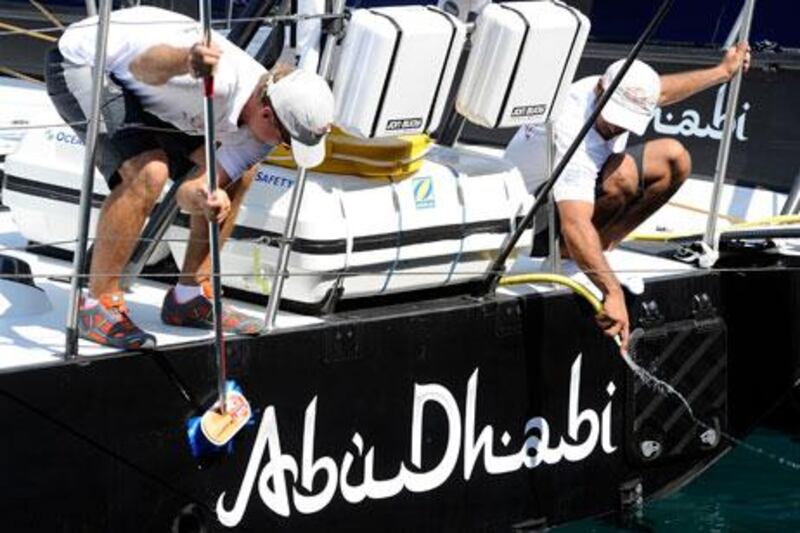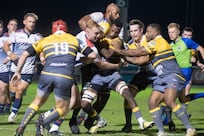Every so often, in the quirky work of sports reporting, there comes an aside so striking that it ups and illuminates an entire sport anew.
Such an utterance came Friday in a tent on the outskirts of the Abu Dhabi Ocean Racing (ADOR) village at the edge of the Atlantic, while the Kiwi team physiotherapist Sarah Burney meticulously explained the vagaries of her work.
She referred to the sailor and physiotherapist Sue Crafer, the ADOR consultant she considers a mentor, and who possesses an uncanny knack regarding elite sailors.
"She can look at a guy walking toward her and say, 'He's been sailing this sort of boat, and doing this sort of job on the boat'," Burney said. Toiling in a setting forever "cramped and lopsided" helps exact profound effects upon the human frame.
Are sailors athletes? Armchair know-it-alls have asked the question, and the only fit answers would go something like, "How can you even ask?" or, more succinctly, "Are you mad?"
Of course they are, and even if the sport's demands for strength, dexterity, quickness and crazy endurance somehow did not convince, you could always listen to the physio for wretched tales of untold tolls upon the human body. Take a nine-month, 39,000 nautical-mile beast such as the Volvo Ocean Race that begins in October, and the aching prospects multiply.
Chronic lower-back pain generally ranks No 1, but, as Burney reported: "Shoulders tend to get beaten up as well." Of late, she saw four consecutive sailors with the identical issue, pain in the high back, born of "always looking up." Lower backs suffer - and strengthen - because, she said, "It's hard to find neutral … The fact that they lie flat in a bunk for a few hours is good."
And: "Hardly anywhere down below there can you stand up."
So tuned-in are these athletes that they prove keen guessers about themselves. Just before the ADOR boat, Azzam, edged out of La Spezia, Italy, in early July for a test run around Spain and Gibraltar and to the Portuguese coast, Burney weighed the sailors. Upon their arrival a-week-and-change later in Cascais, she quickly weighed them again. Every one guessed accurately, she said.
Last Friday, she checked on the skipper about a wrist, and the skipper, Ian Walker, invited a visitor into the physio tent to witness some acupuncture (and really now, among high-profile athletes, when did Tiger Woods or Roger Federer ever invite a reporter to the acupuncture?).
"My wrist is [sore] at the moment," Walker said, holding it, and soon he lay flat on his back with needles here and there, while Burney spoke of the mixture of eastern and western medicine and the need to "get rid of inflammation and pain" in the rebellious wrist.
In the case of the English onboard team member Simon Fisher, she said, the diligent cardio-and-weight training has forged elemental change: "His posture's completely different now. I hardly see him now … He says he feels great sailing now." In the case of the Emirati sailor Butti Al Muhairi, he has tacked on five non-fat pounds so that he looks almost downright ready to play some rugby, if necessary.
As for all athletes, food reigns, such that Burney hands out questionnaires that deal with missed meals at sea, the queries including, "How many meals did you miss?", and "Why did you miss them?" Magnesium matters, as their purified seawater does not supply it, and we all know how elite athletes need magnesium.
Way back when early this year, Burney got started by assessing five sailors and by recommending regimens that would help bring raves about her work from Walker. Some sailors arrived later as ADOR cobbled together its team, so the Kiwi helm/trim Justin Ferris turned up in La Spezia.
"A little bit of a crash-landing with him," Burney said. "He's got lower-back pain and hip pain, and as it gets worse, it goes down his leg. He obviously hadn't found his thing that works." Burney mulled it and reckoned that instead of coming from the back above, the pain might stem from below. "I think now we've actually found it," she said, noting his hip would lock, straining the lower back, which "was pinching on the nerve and he would get a numb thigh".
But trigger-point therapy seems the salve, and good for that, because whether it is Rafael Nadal relating how tennis players always hurt somewhere or an Olympic-medallist sailor with a sore wrist, so go the realities of athletes.
Follow
The National Sport
on
[ @SprtNationalUAE ]
& Chuck Culpeper on
[ @DubaiChuck ]





